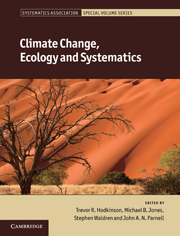Book contents
- Frontmatter
- Contents
- List of contributors
- Preface
- Section 1 Introduction
- 1 Integrating ecology and systematics in climate change research
- 2 Climate modelling and deep-time climate change
- 3 The perils of addressing long-term challenges in a short-term world: making descriptive taxonomy predictive
- Section 2 Adaptation, speciation and extinction
- Section 3 Biogeography, migration and ecological niche modelling
- Section 4 Conservation
- Index
- Systematics Association Publications
- Plate section
- References
2 - Climate modelling and deep-time climate change
from Section 1 - Introduction
Published online by Cambridge University Press: 16 May 2011
- Frontmatter
- Contents
- List of contributors
- Preface
- Section 1 Introduction
- 1 Integrating ecology and systematics in climate change research
- 2 Climate modelling and deep-time climate change
- 3 The perils of addressing long-term challenges in a short-term world: making descriptive taxonomy predictive
- Section 2 Adaptation, speciation and extinction
- Section 3 Biogeography, migration and ecological niche modelling
- Section 4 Conservation
- Index
- Systematics Association Publications
- Plate section
- References
Summary
Abstract
Detailed and reliable understanding of past climate change is a key ingredient in unravelling how climate has influenced life on earth and will continue to do so in the future. Palaeoclimatology and climate modelling have both made rapid strides over the past decades, and there has been fruitful two-way interaction between the two fields. The application of climate models to palaeoclimates has proved useful both in interpreting palaeoclimate proxy data and in testing the robustness and generality of climate models. Here, we give an overview of the current state of climate modelling and review recent progress in understanding deep-time climate change, with emphasis on problems where climate models have played a salient role. By suitably adjusting the concentration of atmospheric greenhouse gases, climate models can be made to replicate many key climatic transitions in the earth's history. However, important discrepancies remain between modelled climates and proxy reconstructions, particularly on the warm end of the spectrum.
Introduction
Climate science deals with reconstructing and explaining the long-term mean and variability of physical conditions in the earth's envelope. A striking feature emerging from such analysis is the vast range of timescales on which there is significant variability. Part of this variability, including the diurnal and annual cycles, is periodic and predictable, but mostly it is random and unpredictable. We know from direct experience that the weather changes from hour to hour, from day to day, and from year to year.
- Type
- Chapter
- Information
- Climate Change, Ecology and Systematics , pp. 44 - 66Publisher: Cambridge University PressPrint publication year: 2011

